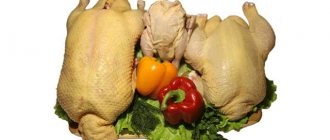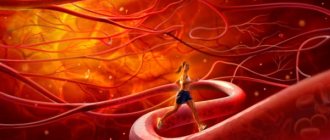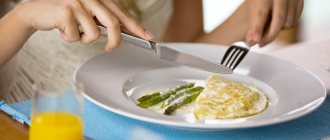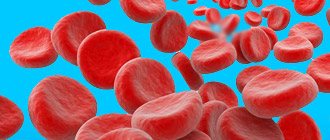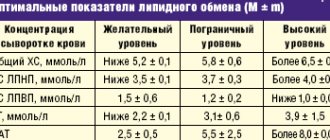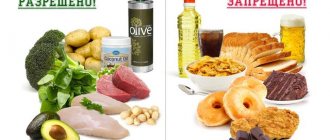The word “cholesterol” usually evokes negative associations with excess weight, poor diet and atherosclerosis. However, only an increase in its level is dangerous to health, and within normal limits this organic compound is vital. Let's find out how to quickly and effectively lower blood cholesterol, including at home. However, first you should find out what cholesterol is, what its role is in the body and what affects the increase in concentration.
Oatmeal, oat bran and fiber-rich foods
Oatmeal contains soluble fiber, which lowers low-density lipoprotein (LDL) levels, the so-called “bad” cholesterol. Soluble fiber is also found in beans, apples, pears, barley and prunes.
Soluble fiber can lower the amount of cholesterol in the blood. 5-10 grams or more of soluble fiber per day reduces total cholesterol and LDL cholesterol. One and a half cups of oatmeal contains 6 grams of fiber. If you add some fruit, such as banana, to your porridge, you'll get about 4 more grams of fiber. For variety, try unprocessed oats or rolled oats containing oat groats or oat bran.
Complications from high cholesterol
High cholesterol is dangerous because it increases the likelihood of developing the following diseases:
- atherosclerosis – accompanied by the formation of atherosclerotic plaques, decreased elasticity of vessel walls, and narrowing of the arteries;
- coronary heart disease – accompanied by narrowing of the coronary artery, which causes myocardial hypoxia and disrupts its functioning;
- hypertension - manifests itself as high blood pressure, against the background of which stroke, heart attack, heart failure and other serious complications are likely;
- stroke - an acute disorder of cerebral circulation as a result of blockage or rupture of a cerebral vessel;
- heart attack – death of a section of the heart muscle due to loss of blood supply.
Most of these diseases are known to be fatal.
High cholesterol at a young age causes early disability and mortality. Due to the increased concentration of LDL, the walls of blood vessels become less elastic, atherosclerotic plaques are deposited on them, which impede blood flow. As a result, blood clots form, which cause heart attack and stroke.
Signs of High Cholesterol:
- heart pain, angina attacks;
- heaviness, pain in the legs even after minor physical exertion;
- the appearance of blood clots with mild bleeding;
- yellow spots on the skin, mainly in the eye area, wen.
More severe symptoms of high cholesterol in men and women appear when LDL levels are at critical levels. This may be a pre-stroke or pre-infarction condition.
The earlier high cholesterol and its causes are identified, the more effective the treatment.
Fish and omega-3 fatty acids
Fish and omega 3 fatty acids
Eating fatty fish is good for your heart because it contains high amounts of omega-3 fatty acids, which reduce blood pressure and the risk of blood clots. In people who have had heart attacks, fish oil and omega-3 fatty acids reduce the risk of sudden death.
Cardiologists recommend eating at least 2 servings of fish per week. The largest amounts of omega-3 fatty acids contain:
- mackerel;
- river trout;
- herring;
- sardines;
- longfin tuna;
- salmon;
- halibut.
To avoid adding unhealthy fats, fish should be baked or grilled. If you don't like fish, you can get some omega-3 fatty acids from foods like flaxseed meal, camelina oil, or canola oil.
Another option is to take omega-3 fatty acid or fish oil supplements, but then you won't get other nutrients that fish also contain (such as selenium). If you plan to use such supplements, please consult your physician first.
List of statin drugs
Which drugs are statins, and what their cholesterol-lowering activity is, can be found in the table below.
| Types of statins | Cholesterol-lowering activity | Name of drugs |
| Rosuvastatin | By 55% | Crestor , Akorta , Mertenil , Roxera , Rosuvastatin , Rozulip , Rosucard , Tevastor , Rozart |
| Atorvastatin | By 47% | Atorvastatin Canon , Atomax , Tulip , Liprimar , Atoris , Torvacard , Liptonorm , Lipitor |
| Simvastatin | By 38% | Zocor , Vazilip , Ovencor , Simvacard , Simvahexal , Simvastatin , Simvor , Simvastol , Simgal, Sincard , Simlo |
| Fluvastatin | By 29% | Lescol Forte |
| Lovastatin | By 25% | Cardiostatin 20 mg, Choletar , Cardiostatin 40 mg |
Classification of statins
In medicine, certain parameters are taken into account for classification.
Origin:
- Synthetic: Cerivastatin , pitavastatin , Rosuvastatin , Fluvastatin , Atorvastatin ).
- Semi-synthetic: Simvastatin , Pravastatin .
- Natural: Lovastatin .
By generation:
- First generation: lovastatin ( Choletar , Cardiostatin );
- Second generation: simvastatin ( Vasilip , Simvacard , Simvastatin , Simvor , Simvastol , Simgal , Zocor , Owencor , Sincard , etc.), pravastatin ;
- Third generation: atorvastatin ( Atomax , Tulip , Liprimar , Atoris , Torvacard , Liptonorm , Lipitor ), cerivastatin , fluvastatin .
- Fourth generation: pitavastatin , rosuvastatin ( Crestor , Akorta , Mertenil , Roxera , Rosuvastatin , Rozulip , Rosucard , Rozart , Tevastor ).
Walnuts, almonds and other nuts
Benefits of nuts
Walnuts, almonds and other nuts can improve your cholesterol levels. Rich in mono- and polyunsaturated fatty acids, walnuts also help support vascular health.
Eating a handful of almost any type of nut (almonds, hazelnuts, peanuts, pecans, pine nuts, pistachios, walnuts) daily can reduce your risk of heart disease. When choosing nuts, make sure that they are without added salt or sugar.
All nuts are high in calories, so a handful (40-45 g) will be enough. To avoid overeating and weight gain, replace foods rich in saturated fat with nuts. For example, instead of cheese, meat or croutons, add a handful of walnuts or almonds to your salad.
Summarizing
The choice of appropriate drugs for high cholesterol is the prerogative of the attending physician. Only a specialist is able to assess the patient’s health and select pills for him depending on the indications and taking into account existing contraindications. When choosing medications, you cannot focus only on cost.
Cheap products may not always be of high quality, although a high price does not guarantee a quick and long-lasting effect. It is better to stick to the golden mean, follow the doctor's instructions and take the pills strictly according to the plan. Then the prescribed drug will be beneficial and will not have side effects on the body.
Olive oil
The benefits of olive oil
Another good source of MUFA is olive oil.
To benefit your heart, try to consume 2 tablespoons (23 g) of olive oil daily, replacing other fats. You can sauté vegetables in olive oil, add it to marinades, or mix it with vinegar for salad dressings. When frying meat, use olive oil instead of butter.
Both avocados and olive oil are high-calorie foods, so don't eat more than the recommended amount.
How to choose statins?
Despite all the reviews about statins for lowering cholesterol, the patient must decide whether to take such medications, but this should be done only on the basis of the recommendation of a specialist. What is important, first of all, is not the reviews, but the doctor’s prescription.
If a person nevertheless decides to take statins, then the choice factor should not be the price of the drug, but, first of all, the presence of chronic diseases.
Self-treatment if cholesterol is elevated cannot be carried out with any medications. Treatment for high cholesterol and lipid metabolism disorders is prescribed by a cardiologist or therapist. In this case, the specialist must assess the following risks:
- age;
- floor;
- weight;
- presence of bad habits;
- diseases of the cardiovascular system, other diseases (diabetes, etc.).
It is important to take statins in the dose prescribed by your doctor, and it is important to take a biochemical blood test as often as prescribed by a specialist.
If too expensive pills were prescribed, you can ask the doctor to replace them with drugs that are cheaper. However, it is recommended to use original drugs, since domestically produced generics are of lower quality than the original drug and generics offered by imported manufacturers.
Those who, before taking them, are interested in what the real benefits and harms of statins against cholesterol are, need to consider several important factors in order to minimize the harm of these drugs.
If the medicine is prescribed to elderly patients, it must be taken into account that the risk of myopathy doubles if taken together with medications for hypertension , gout , diabetes .
For chronic liver diseases, it is advisable to take Rosuvastatin in low doses; Pravastatin ( Pravaxol ) can also be used. These drugs provide liver protection, but when using them, you should absolutely not drink alcohol or practice antibiotic .
If there is constant muscle pain or there is a risk of muscle damage, it is also advisable to use Pravastatin, since it is not so toxic to the muscles.
People with chronic kidney disease should not take Fluvastin Lescol , nor should they take Atorvastatin calcium ( Lipitor ), as these medications are toxic to the kidneys.
If a patient seeks to lower low-density cholesterol, it is recommended to use different types of statins.
Currently, there is no clear evidence that it is advisable to take a combination of statins plus nicotinic acid. When taking nicotinic acid, people with diabetes may have a decrease in blood sugar, attacks of gout, bleeding from the gastrointestinal tract are also possible, and the likelihood of rhabdomyolysis and myopathies .
Products with added plant sterols and stanols
Products are available that are fortified with sterols or stanols, plant substances that block the absorption of cholesterol.
Some margarines, orange juice and drinking yogurts with added plant sterols can reduce LDL levels by 5-15%. To see results, you need to consume at least 2 grams of plant sterols per day, which equates to about 2 glasses of sterol-fortified orange juice.
It is unclear whether foods containing plant sterols and stanols reduce the risk of heart attacks and strokes, although experts believe that cholesterol-lowering foods also reduce the risk of cardiovascular complications. Plant sterols and stanols do not affect the level of triglycerides and high-density lipoproteins (HDL), the so-called “good” cholesterol.
Who needs to take statins?
Informing what statins are, advertising stories and instructions for the drugs indicate that statins are effective drugs for lowering cholesterol, which significantly improve the overall quality of life, and also reduce the likelihood of developing strokes and myocardial infarction . Accordingly, taking these pills every day is a safe method to lower your cholesterol levels.
But in fact, until today there is no accurate information about whether treating patients with such medications is really so safe and effective. After all, some researchers claim that the potential harm and side effects outweigh the benefits of statins as a prophylactic drug used to prevent cardiovascular diseases. Experts are still arguing whether it is worth taking statins, weighing the pros and cons. Doctors' forums almost always contain debates on the topic “Statins - pros and cons.”
But, nevertheless, there are certain groups of patients for whom statins are required.
The latest generation statins must be used:
- for the purpose of secondary prevention after a stroke or heart attack ;
- for reconstructive surgical interventions on large vessels and the heart;
- in case of myocardial infarction or acute coronary syndrome ;
- with ischemic disease with an increased likelihood of stroke or heart attack.
That is, anticholesterol drugs are indicated for coronary patients in order to increase their life expectancy. In this case, to reduce side effects, the doctor must select the appropriate medicine and monitor biochemical parameters. If there is a 3-fold increase in transaminases, statins are discontinued.
The advisability of prescribing medications from this group for such patients is questionable:
- at low risks;
- for diabetes mellitus ;
- in women before menopause.
If statins are prescribed to people with diabetes, they may need additional tablets to lower their blood , since statins raise their blood sugar in such patients. Medicines to lower blood sugar should only be prescribed and their dosage adjusted by a doctor.
Currently in Russia, the treatment standards for most cardiac pathologies include the use of statins. But although medical prescription reduces mortality, this is not a prerequisite for prescribing drugs to all people with coronary artery disease or hypertension. They should not be used by anyone over 45 years of age or by anyone with high cholesterol levels.
It is important to consider the compatibility of these drugs with other drugs.
If necessary, together with anticholesterol drugs, the doctor prescribes other drugs for the treatment of cardiovascular diseases: Diroton , Concor , Propanorm , etc.
Diroton (active ingredient - lisinopril ) is used to treat arterial hypertension.
Concor (active component - bisoprolol hemifumarate ) is used for the treatment of arterial hypertension , heart failure, angina pectoris .
Other dietary changes
For these products to really be beneficial, you will have to reconsider your diet and adjust your lifestyle.
Although the benefits of some types of fats were discussed above, the consumption of others - saturated fats and trans fats - should be limited. Saturated fats, found in meats, butter, cheese and other full-fat dairy products, as well as some vegetable oils, raise total cholesterol levels. Trans fats, often used in margarines or store-bought cookies, crackers or cakes, are especially unhealthy. They increase LDL and decrease HDL - the so-called. “good” cholesterol. If a product label says “partially hydrogenated oils,” the product contains trans fats and is best avoided.
In addition to changing your diet, you should also adjust your overall lifestyle - this is the key to improving your cholesterol levels. Exercise, quitting smoking and maintaining a healthy weight will help you normalize your cholesterol levels.
Make an appointment Do not self-medicate. Contact our specialists who will correctly diagnose and prescribe treatment.
Side effects
Numerous negative effects may occur after administration:
- Frequent side effects: asthenia , insomnia , headache , constipation , nausea , abdominal pain, diarrhea , myalgia , flatulence .
- Digestive system: diarrhea, vomiting, hepatitis, pancreatitis , cholestatic jaundice, anorexia .
- Nervous system: dizziness , amnesia, hypoesthesia, malaise, paresthesia, peripheral neuropathy.
- Allergic manifestations: rash and itching of the skin , urticaria , anaphylaxis , exudative erythema, Lyell's syndrome.
- Musculoskeletal system: back pain, myositis , cramps , arthritis , myopathy .
- Hematopoiesis: thrombocytopenia .
- Metabolic processes: hypoglycemia , diabetes mellitus , weight gain, obesity , impotence , peripheral edema.
- The most severe complication of statin treatment is rhabdomyolysis , but this occurs in rare cases.
Fibrates: what is it?
Fibrates are also used to lower cholesterol. These drugs are fibric acid . They bind to bile acid, thereby reducing the active production of cholesterol by the liver.
Fenofibrates medicinally lower lipid , which in turn leads to lower cholesterol. According to clinical studies, the use of fenofibrates lowers cholesterol by 25%, triglycerides by 40-50%, and also increases the level of so-called “good” cholesterol by 10-30%.
Instructions for the use of fenofibrates and ciprofibrates indicate that with high cholesterol levels, these drugs reduce the amount of extravascular deposits, and also reduce cholesterol and triglyceride levels in patients with hypercholesterolemia .
List of fenofibrate drugs:
- Thaicolor;
- Lipantil;
- Exlip 200;
- Ciprofibrate Lipanor;
- Gemfibrozil.
But, before you buy and take such medications, you should keep in mind that taking them leads to certain side effects. As a rule, various digestive disorders most often occur: flatulence , dyspepsia , diarrhea , vomiting .
The following side effects have been reported after taking fenofibrates:
- Digestive system: pancreatitis , hepatitis, vomiting, abdominal pain, nausea, diarrhea, flatulence, the appearance of gallstones.
- Musculoskeletal system: muscle weakness, rhabdomyolysis, diffuse myalgia, myositis, spasms.
- Nervous system: headache, sexual dysfunction.
- Heart and blood vessels: pulmonary embolism, venous thromboembolism.
- Allergic manifestations: skin itching and rash, photosensitivity, urticaria .
Combining statins with fibrates is practiced to reduce the dosage and, accordingly, the negative effects of statins.
Drug combinations
In addition to using the drugs separately, they can be combined together to enhance the lipid-lowering effect. Sometimes statins need help fighting high cholesterol. Taking statins can be combined with the use of drugs that intensively remove bile acids from the body. Statins are also combined with drugs that inhibit cholesterol absorption or a PCSK9 inhibitor. Statins are the base drug in all drug combinations. The decision to use drugs together is made by the doctor[2].
Other Important Recommendations
At the moment, no medical community dares to recommend natural remedies as the only method of treatment. It will take several more (perhaps even decades) years for clinical observational data to become firmly established in the health care systems of various countries. At the moment, the treatment regimen for dyslipidemia cannot be done without drugs and is presented as follows:
- Lifestyle changes. Involves regular walks in the fresh air (parks, coniferous forests). The recommended number of steps per day is 8,000 (according to the World Health Organization).
- Quitting bad habits (alcohol, smoking, drugs).
- Body weight control. With a weight loss of 10 kg, the risk of sudden vascular death drops by 20%, and in the presence of diabetes mellitus - by 30%. A decrease in body weight by 15 kg has a pronounced effect on systolic and diastolic blood pressure - a decrease of 10 mm. rt. Art. and by 20 mm. rt. Art. respectively.
- Prescription of medications (fibrates, statins, bile acid sequestrants, vitamin PP preparations).
- Follow a diet limiting fatty, spicy, salty, and sweet foods.
- In case of severe dyslipidemia, prevention of complications (Aspirin, Xarelta, etc.).
Fully or partially limited products
Excluded: pork, cooking fats, refined vegetable oil, margarine, butter, duck and goose meat, offal (kidneys, brains, liver), sausages and smoked meats. Fatty fish, fish roe (contains a large amount of cholesterol), crayfish, shrimp, crabs and any canned fish, including cod liver, are prohibited.
You should not consume puff pastry and pastry products, highly extractive meat, fish, or mushroom broths. Cream, fatty cottage cheese and sour cream are not allowed in the diet. Prohibition of consumption of chocolate, full-fat ice cream, products with cream and products with palm and coconut oil. Mayonnaise and ketchup should not be used as sauces.
Limit:
- beef (1-2 times a week);
- red fish;
- egg yolks;
- potato;
- fatty cheeses;
- nuts;
- buckwheat;
- honey.
Table of prohibited products
| Proteins, g | Fats, g | Carbohydrates, g | Calories, kcal | |
Fruits | ||||
| bananas | 1,5 | 0,2 | 21,8 | 95 |
Nuts and dried fruits | ||||
| raisin | 2,9 | 0,6 | 66,0 | 264 |
Cereals and porridges | ||||
| semolina | 10,3 | 1,0 | 73,3 | 328 |
| white rice | 6,7 | 0,7 | 78,9 | 344 |
Flour and pasta | ||||
| pasta | 10,4 | 1,1 | 69,7 | 337 |
Bakery products | ||||
| bagels | 16,0 | 1,0 | 70,0 | 336 |
| bagels | 16,0 | 1,0 | 70,0 | 336 |
| crackers | 11,2 | 1,4 | 72,2 | 331 |
Confectionery | ||||
| jam | 0,3 | 0,2 | 63,0 | 263 |
| jam | 0,3 | 0,1 | 56,0 | 238 |
| candies | 4,3 | 19,8 | 67,5 | 453 |
| pastry cream | 0,2 | 26,0 | 16,5 | 300 |
Ice cream | ||||
| ice cream | 3,7 | 6,9 | 22,1 | 189 |
Cakes | ||||
| cake | 4,4 | 23,4 | 45,2 | 407 |
Chocolate | ||||
| chocolate | 5,4 | 35,3 | 56,5 | 544 |
Raw materials and seasonings | ||||
| ketchup | 1,8 | 1,0 | 22,2 | 93 |
| mayonnaise | 2,4 | 67,0 | 3,9 | 627 |
Dairy | ||||
| cream | 2,8 | 20,0 | 3,7 | 205 |
| sour cream 30% | 2,4 | 30,0 | 3,1 | 294 |
| sour cream 40% (fat) | 2,4 | 40,0 | 2,6 | 381 |
Cheeses and cottage cheese | ||||
| cheese | 24,1 | 29,5 | 0,3 | 363 |
| cottage cheese 18% (fat) | 14,0 | 18,0 | 2,8 | 232 |
Meat products | ||||
| pork | 16,0 | 21,6 | 0,0 | 259 |
| pork liver | 18,8 | 3,6 | 0,0 | 108 |
| pork kidneys | 13,0 | 3,1 | 0,0 | 80 |
| pork fat | 1,4 | 92,8 | 0,0 | 841 |
| salo | 2,4 | 89,0 | 0,0 | 797 |
| beef liver | 17,4 | 3,1 | 0,0 | 98 |
| beef kidneys | 12,5 | 1,8 | 0,0 | 66 |
| beef brains | 9,5 | 9,5 | 0,0 | 124 |
| mutton | 15,6 | 16,3 | 0,0 | 209 |
Sausages | ||||
| smoked sausage | 16,2 | 44,6 | 0,0 | 466 |
| smoked sausage | 9,9 | 63,2 | 0,3 | 608 |
| sausages | 10,1 | 31,6 | 1,9 | 332 |
| sausages | 12,3 | 25,3 | 0,0 | 277 |
Bird | ||||
| smoked chicken | 27,5 | 8,2 | 0,0 | 184 |
| duck | 16,5 | 61,2 | 0,0 | 346 |
| smoked duck | 19,0 | 28,4 | 0,0 | 337 |
| goose | 16,1 | 33,3 | 0,0 | 364 |
Fish and seafood | ||||
| smoked fish | 26,8 | 9,9 | 0,0 | 196 |
| salted fish | 19,2 | 2,0 | 0,0 | 190 |
| Red caviar | 32,0 | 15,0 | 0,0 | 263 |
| black caviar | 28,0 | 9,7 | 0,0 | 203 |
| squid | 21,2 | 2,8 | 2,0 | 122 |
| shrimps | 22,0 | 1,0 | 0,0 | 97 |
| salmon | 19,8 | 6,3 | 0,0 | 142 |
| sturgeon | 16,4 | 10,9 | 0,0 | 163 |
| canned fish | 17,5 | 2,0 | 0,0 | 88 |
| semi-finished fish products | 12,5 | 6,7 | 14,7 | 209 |
| sardine | 20,6 | 9,6 | — | 169 |
| mackerel | 18,0 | 13,2 | 0,0 | 191 |
| cod (liver in oil) | 4,2 | 65,7 | 1,2 | 613 |
| boiled oysters | 14,0 | 3,0 | — | 95 |
| fresh oysters | 14,0 | 6,0 | 0,3 | 95 |
Oils and fats | ||||
| butter | 0,5 | 82,5 | 0,8 | 748 |
| creamy margarine | 0,5 | 82,0 | 0,0 | 745 |
| coconut oil | 0,0 | 99,9 | 0,0 | 899 |
| palm oil | 0,0 | 99,9 | 0,0 | 899 |
| rendered beef fat | 0,0 | 99,7 | 0,0 | 897 |
| cooking fat | 0,0 | 99,7 | 0,0 | 897 |
| rendered pork fat | 0,0 | 99,6 | 0,0 | 896 |
Non-alcoholic drinks | ||||
| cola | 0,0 | 0,0 | 10,4 | 42 |
| lemonade | 0,0 | 0,0 | 6,4 | 26 |
| Pepsi | 0,0 | 0,0 | 8,7 | 38 |
| sprite | 0,1 | 0,0 | 7,0 | 29 |
| * data is per 100 g of product | ||||
